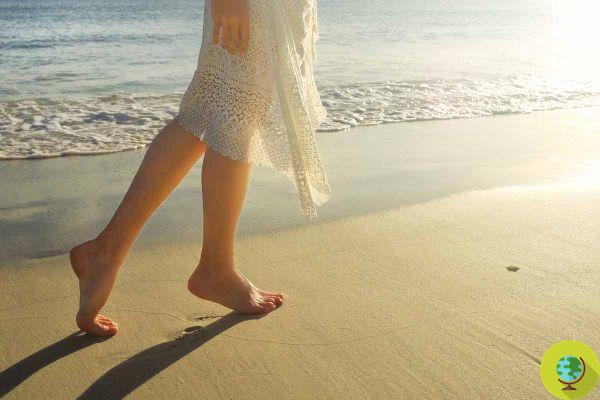
Walking on the beach offers many benefits and, to do it better, just follow a few simple tips
Walking on the beach is a healthy activity as well as a pleasant and relaxing one. So here are all the benefits that a nice walk by the sea offers and some useful tips to optimize your walk.
The scent of the sea, the sound of the waves, the wet sand on the shore and in general everything that the beach offers is a perfect setting for a walk. Walking by the sea is a truly wonderful way to clear your mind and keep your body exercising.
Among other things, the surface on which we walk can make the difference: a softer base like grass and sand is especially useful for those with back and spine problems but it is also ideal for those who want to lose weight.
The benefits of walking on the sand
Walking on sand actually requires more effort than walking on a hard surface. The muscles and tendons will work harder, strengthening the foot and ankle. In addition, the walks on the beach allow you to burn more calories.
A walk by the sea is ideal for those with pain in the knees, back and hips, since the sand makes contact with the earth less "hard", which makes the task easier for bones and joints, as also demonstrated by a study.
But that is not all. As physiotherapist Ashley Estanislao said:
Be outdoors and surrounded by the rhythm of the waves has a calming effect on our nervous system. Walking on the beach can help relieve stress, and the sun can help our bodies synthesize vitamin D.
Other health benefits include:
- Exfoliation: sand is a natural exfoliant. Walking barefoot removes dead skin cells and softens the toes.
- Strength training: The increased resistance will strengthen the muscles between the feet and back, especially the calves, quadriceps and glutes.
- Weight loss: Walking on the beach can help you lose weight. A 2020 study found that walking on sand leads to a greater reduction in waist circumference than walking on the sidewalk: 5,3cm vs 3cm, respectively.
- Reduced risk of injury: A 2013 study found that sand training increases strength and prevents injuries by having less impact.
As we said, walking on the beach also contributes to weight loss. But how many calories do you burn walking on the sand? The amount is determined by both the speed and the weight of the person but in general, as Allen Conrad, certified trainer and chiropractor said:
Since your body uses muscles in a different way when walking on sand, you will burn about one and a half to two times more calories than normal walking. The accessory muscles of the legs and back have to exert more effort to keep you stable when walking on the sand and [the extra effort] burns additional calories.
This claim is also supported by science. Although there are limited studies conducted specifically on sand, research from a few years ago looked at the body's calorie expenditure when walking on uneven ground and found that muscles work between 26-68% more.
Tips for optimizing a walk on the beach
If we want to optimize our walk on the beach we must take into account some factors:
- The density of the sand: softer sand provides easier work for bones and joints than wet, compact sand. The softer sand will also help build more stamina and strength. But for those with lower body injuries, it may be best to walk on firmer sand.
- The distance or duration of the walk: those who are not used to walking on the beach often should start gradually. In fact, sand strains your muscles more than a treadmill or sidewalk does.
- ShoesAlthough some people prefer to walk barefoot, those who take a longer walk may want to wear athletic shoes that will support arches and ankles and protect their feet from the possible presence of glass, metal or sharp shells hidden in the sand.
- Drink lots of water before and during your workout: the ideal would be to drink a few sips about every 15 minutes.
- Don't forget the sunscreen: even on cloudy days, the sun's ultraviolet rays can cause burns.
- Use a pedometer: can help you keep track of your workout.
- Motivation: walking at sunrise or sunset can be very stimulating but also having the company of a friend.
Read all of our articles on the benefits of walking.
Follow us on Telegram | Instagram | Facebook | TikTok | Youtube
Read also:
- Walking in the water, all the benefits of walking by the pool or by the sea
- Walking barefoot: how healthy is it?


























